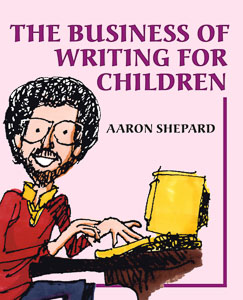Manuscripts from beginning writers often bog down from lack of enough dialog and action. If you have this problem, here’s a suggestion: Script your story!
Since I have no kids, my introduction to children’s literature was somewhat unusual. In 1986, I was in need of a part‑time job and, being already interested in storytelling—for adults—I arranged to join a reader’s theater troupe. This wonderful organization had been professionally performing adaptations of children’s literature in public schools throughout the county for over a decade. I soon discovered that I loved performing for kids, and loved children’s literature as well.
My five years with the troupe taught me to think of stories primarily in terms of dialog and action—because these are the main components of performance. (Though reader’s theater is often performed without stage movement, the group that I worked with would mime the stories to help keep young people’s interest.) I learned that kids are almost entirely focused on what characters do and say. In fact, they watch the characters even while a narrator is speaking.
After a while, I began contributing my own adaptations of favorite stories to the troupe’s repertoire, and this led to other discoveries. I found that some stories required drastic simplification and cuts in narration to make them work in performance.
On the other hand, stories from some of the best and most popular children’s authors almost scripted themselves. Nearly all that was needed was to take out the “tags”—the “he saids” and “she saids”—and split the text into character and narrator speaking parts. These authors were already writing to create vivid, living scenes on the stage of the child’s imagination—the reader’s theater of the mind.
Today, when I write my own stories, one corner of my mind is always asking, “How does this work on stage?” As a result, I turn out stories that are—I hope—lively and interesting to kids.
Not every children’s writer can have the benefit of years in reader’s theater. But any children’s writer can use reader’s theater techniques to test or enhance their writing. Here’s how:
Try sitting down with one of your short story or picture book manuscripts and adapting it into a script. Just split up the text into speaking parts for characters and a narrator, adding an identifier in front of each speech. Leave out tags that don’t contain important information.
Sample script pages (PDF, 2 pages)
What happens? Do the characters have enough to say? Or are they waiting around for the narrator to get through a page or two? As a rule of thumb, most narrator speeches should consist of only one or two kid‑sized paragraphs. (Allow an extra paragraph where there’s a “scene change.”) No more than two or three narrator speeches should be any longer.
If that’s not what you have, check whether you need all that narration, or whether you can move some of the character dialog into the middle, or—best yet—whether you can convert narration into speeches for the characters. A narrator should say only what the characters can’t.
While you’re there, check your action. Visualize the stage and how the characters are going to move on it. Does it all make sense? Did you describe something physically impossible? Did you leave out something vital? Is it too busy? Not busy enough? Is the number of characters about right, or is the stage too crowded?
If you’re brave, you could test the script by asking critique group members or other friends to read it while you listen. And if you’re positively courageous, you and your friends could perform it for kids!
Another useful approach would be to write a story first as a script. This would practically guarantee enough dialog and action. Afterwards, you could join together the text and insert the tags.
A good script can have other uses too. I learned that at least one top children’s magazine had been looking—with little success—for short scripts to complement its stories. Scripts can also be used in promotion. For instance, when you start visiting schools, classes might like to perform scripts of your publications.
So consider scripting your stories. It can give you valuable insights into your work, provide new avenues of publication and promotion, and be great fun as well.
